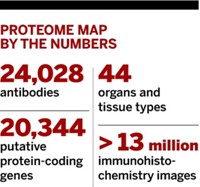Advertisement
Grab your lab coat. Let's get started
Welcome!
Welcome!
Create an account below to get 6 C&EN articles per month, receive newsletters and more - all free.
It seems this is your first time logging in online. Please enter the following information to continue.
As an ACS member you automatically get access to this site. All we need is few more details to create your reading experience.
Not you? Sign in with a different account.
Not you? Sign in with a different account.
ERROR 1
ERROR 1
ERROR 2
ERROR 2
ERROR 2
ERROR 2
ERROR 2
Password and Confirm password must match.
If you have an ACS member number, please enter it here so we can link this account to your membership. (optional)
ERROR 2
ACS values your privacy. By submitting your information, you are gaining access to C&EN and subscribing to our weekly newsletter. We use the information you provide to make your reading experience better, and we will never sell your data to third party members.
Proteomics
Method uncovers synaptic vesicles’ hidden proteome
Researchers find 3 times as many synaptic proteins as previously identified
by Celia Henry Arnaud
January 2, 2021
| A version of this story appeared in
Volume 99, Issue 1
Synaptic vesicles are tiny, membrane-enclosed compartments that package and release messenger compounds, such as neurotransmitters, in neurons. Researchers have identified common proteins associated with synaptic vesicles, but they think many low-abundance proteins found in subsets of vesicles remain hidden. An improved inventory of such proteins could be useful for understanding brain diseases.
To dig up such hidden proteins, Zacharie Taoufiq and Tomoyuki Takahashi of the Okinawa Institute of Science and Technology Graduate University, Reinhard Jahn of the Max Planck Institute for Biophysical Chemistry, and coworkers have developed a method for revealing the proteome of subcellular compartments (Proc. Natl. Acad. Sci. U.S.A. 2020, DOI: 10.1073/pnas.2011870117). The approach involves digesting proteins with two enzymes that target different cleavage sites, followed by separating the peptides with two chromatographic methods before mass spectrometric detection.
Using the method with synaptic vesicles purified from rat brains, the researchers identified 1,466 proteins, more than three times as many proteins as had been previously identified. They were able to identify multiple transporters that had been predicted but not seen in synaptic vesicles, including ones with unknown functions.
By comparing levels of proteins found in synaptic vesicles with those found in a nearby part of the neuron, the team categorized proteins found in vesicles as either “resident” or transiently present “visitor” proteins. Even those categorized as residents could be present at extremely low levels—many at less than one copy per vesicle on average. This suggests that synaptic vesicles may each be more specialized in what they transport than previously thought.




Join the conversation
Contact the reporter
Submit a Letter to the Editor for publication
Engage with us on Twitter